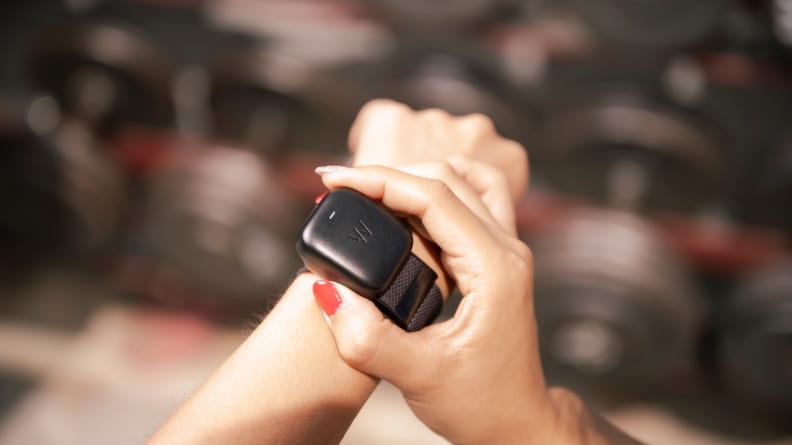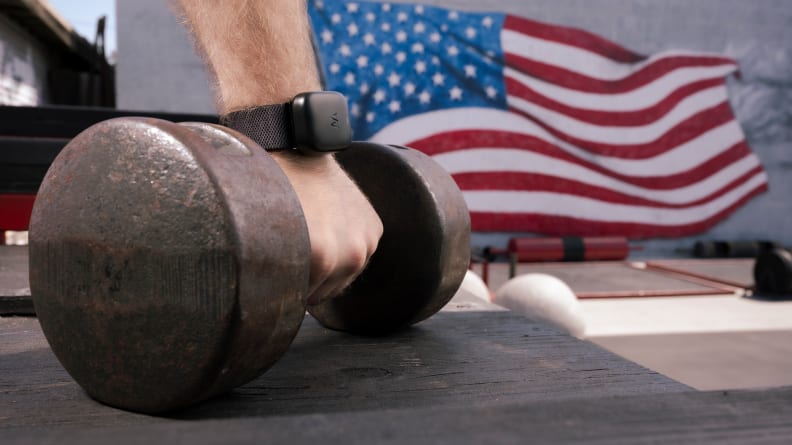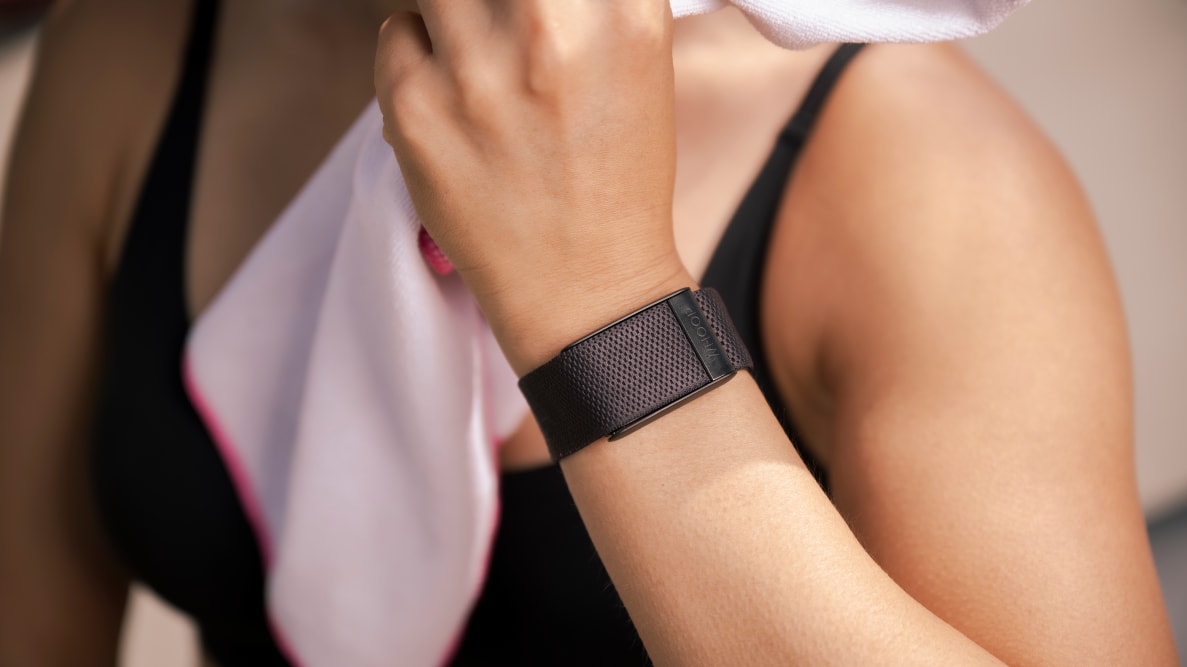Pros
-
Comfortable to wear
-
Makes data points easy to understand
Cons
-
Higher-than-average price
-
Slow companion app
What is the Whoop 4.0?

Paired with the Whoop app and a monthly membership, this lightweight wearable band is the ultimate fitness tracker.
The Whoop 4.0 is a fitness tracker that aims to help you optimize your exercise and recovery time. It tracks health metrics like your pulse, heart rate variability, blood oxygen levels, and skin temperature, as well as sleep data like the time spent in each sleep stage, efficiency (the amount of time in bed you actually spend asleep), and respiratory rate. It offers automatic activity and sleep tracking, as well as manual tracking of over 80 workouts and recovery activities, such as massages or ice baths.
To help users better understand the information it records, Whoop turns your health data into three scores to indicate your “strain,” sleep, and recovery levels. The strain score is measured on a scale from zero to 21 and is calculated based on the amount of time spent in an elevated heart rate zone—the more time you spend in an elevated zone, the higher your score. Whoop’s sleep and recovery scores range from 0% to 100% and, similar to the strain score, the more rested and relaxed you are, the higher your scores.
The roughly 1-inch wide screenless tracker attaches to a nylon and elastane band, which comes in 50 colors with various hardware finishes. The Whoop includes a detachable battery pack that you can slide on top of your tracker to recharge whenever the battery runs low, so you don’t have to worry about forgetting the Whoop in the charger and miss tracking a workout or night’s rest. In my tests, I found I got about four or five days of battery life per full charge, which took about two hours to top up.
How much does the Whoop 4.0 cost?
Unlike other fitness trackers, the main expense of using the Whoop 4.0 is the membership fee to use its companion app—and without that, the device itself is totally useless. The subscription costs $360 a year if you pay monthly at $30, $300 for one year if you pay up front (or $25 a month), or $480 for two years ($240 a year or $20 a month). The basic black wearable is included with Whoop’s subscription fees, though different color straps will cost you an additional $49 to $99.
What we like about the Whoop 4.0
The insights into overall health

Whoop helped me to choose healthy workout patterns, monitored my diet, and encouraged me to journal to form healthier lifestyle habits.
I enjoyed getting insight into my fitness, sleep, and recovery with Whoop, and thought the calculated scores accurately reflected my energy levels for the day. Seeing my strain scores go up with regular exercise kept me motivated, and noticing when my recovery score was lower helped me decide when to take active recovery or rest days.
Whoop makes it easy to see how everyday habits contribute to your overall well being. In addition to giving you scores, Whoop has an in-app journal where you can record your daily habits. You can select from over 100 activities you want to track, such as whether or not you had caffeine, used CBD, or consumed dairy. The app prompts you every day to record whether you performed those activities or not. I chose to record whether or not I drank alcohol, did any meditation, or experienced any stress. Logging this info allowed me to examine how they affected my energy levels and decide if I wanted to prioritize making healthier habits.
The helpful sleep coach
Wearing the Whoop helped me get better sleep. I set a daily wake-up time in the app and told Whoop whether I wanted to hit my “peak” and get all of the sleep recommended, “perform” and get 85% of the sleep recommended, or “get by” with 70% of the sleep recommended. You can change your answers day-to-day, though I typically aimed to get peak or performance level ZZZ’s. The Whoop device itself vibrates as a haptic alarm to wake you at your desired time.
Whoop calculates how much sleep you need based on recent strain and sleep patterns and prompts you to wind down at night. I found these reminders helpful, as I’m not one for watching the clock and typically wait until I start to feel tired before heading to bed.
Its comfortable, thoughtful design

The Whoop website highlights that they use durable SuperKnit bands constructed with your comfort in mind.
The Whoop is wider than some other fitness trackers I’ve worn, which I was worried would make the tracker feel bulky, but it was surprisingly comfortable. The cloth band is soft and just stretchy enough to feel secure on my wrist but not overwhelmingly taut. I also appreciated that it doesn’t have a screen, which could be a big plus for someone who avoids blue light at night.
I’m also a fan of the portable charger. Though it’s not the end of the world if you forget to wear your fitness tracker for a day or two, I’m particularly prone to forgetting mine in the charger, and I get annoyed when I miss gathering data on a night’s sleep.
What we don’t like about the Whoop 4.0
The app’s sluggishness

Unfortunately, the Whoop app won't provide you with frequent up-to-date notifications.
Whoop’s app was intuitive to use, but slow to refresh. I don’t usually leave apps open on my phone, and when it comes to fitness trackers, I usually only open the companion apps once in the morning to see how I slept and once or twice later on in the day to review any workouts I completed or steps taken. Typically this isn’t an issue and the tracker syncs within a minute, but it took several minutes and several refreshes to sync the Whoop tracker with the app, which was a pain to wait for.
The ongoing cost to use it
Whoop’s subscription model makes it more expensive to use long term than some other fitness trackers. Getting the included basic black band and the most cost-effective 24-month subscription comes to $480 for those two years of use. Our favorite fitness tracker, the Fitbit Charge 5, retails for $150. Even if you combine that with an $80 annual subscription to Fitbit Premium (which isn’t required to use the Charge 5, though will unlock the more advanced data comparable to Whoop’s), you’ll spend $310 over the same two-year time period. Although I enjoyed using the Whoop 4.0, I’m not convinced it offers anything special enough to justify the higher cost.
How does Fitbit compare to Whoop?
Fitbit is arguably the name in health tracking wearables and, indeed, it makes several of the best fitness trackers we’ve tested. Whoop tracks many of the same attributes, though its tracker doesn’t function as a wrist watch or smartwatch like Fitbit’s devices do, so if you want that functionality in something you’re wearing all the time, you’ll have to pass on Whoop.
With Whoop, you won’t pay for the device itself, though you can pay for a different colored wrist band or Whoop Body accessory like the Whoop Anywhere Bralette, that lets you move the tracker off your wrist to a pocket inside the bra band. But as mentioned, you’ll pay a subscription fee to use the app, from $20 to $30 a month (based on how much you pay in advance). With Fitbit you pay for the tracker up front—our favorite, the Charge 5, costs $150, while the top-of-the-line Fitbit Sense costs $300 for the basic unit. However, you also have to sign up for Fitbit Premium for an additional $10 per month (or $80 per year if you pay up front) to unlock similar stats to the Whoop’s.
Whoop’s sleep, strain, and recovery scores are comparable to Fitbit Premium’s “readiness” score, which takes recent exercise and sleep patterns into account and gives you a number from one to 100 that indicates how much movement or rest you should aim for. You can view your heart rate and sleep data with Fitbit’s free version of the app, but will only be able to view the readiness score with Fitbit Premium.
Both Whoop and Fitbit Premium summarize your data to help you see what areas have improved or declined over time, a helpful feature you won’t get with Fitbit’s free subscription. Additionally, both offer sleep programming to help you build better bedtime habits. However, Fitbit Premium also offers workouts and exercise programs, something Whoop currently does not.
Is the Whoop worth it?

If you're someone who wants to be completely immersed in their fitness journey, the Whoop 4.0 is the perfect investment.
Maybe, if you don’t mind the ongoing expense
The Whoop 4.0 is a product I would love to continue using. It’s comfortable to wear and seamless to integrate into my daily routine. I especially enjoyed using the journal and seeing how certain activities impacted my strain, sleep, and recovery scores.
But the Whoop membership can get expensive, and its features aren’t exactly unique. Though I found the journal prompts helpful, you could keep track of this information yourself with a pen and paper or in the notes app on your phone. You may not get exact recovery percentages based on your heart rate variability and sleep phases, but you can still record the same end result: how well-rested you feel and how much energy you have throughout the day. Finally, while I didn’t mind that this wrist wearable lacks a screen and the usual watch-like functions, if you’re someone who wants to see even just the time at a glance from a device on your arm, you won’t get that with Whoop. If you want that—plus instant data like pulse readings from the heart rate monitor during a workout—or smartwatch features, you’ll be happier with the Fitbit Charge 5 or the Apple Watch.
If it’s important to see information like exercise recovery quantified based on real data points, you’ll love the Whoop and all the details it can give you. But more casual exercisers can probably skip this high-end fitness tracker—and its high-end price tag.
Meet the tester

Esther Bell
Senior Staff Writer, Health and Fitness
Esther is a writer at Reviewed covering all things health and fitness.
Checking our work.
Our team is here to help you buy the best stuff and love what you own. Our writers, editors, and experts obsess over the products we cover to make sure you're confident and satisfied. Have a different opinion about something we recommend? Email us and we'll compare notes.
Shoot us an email


